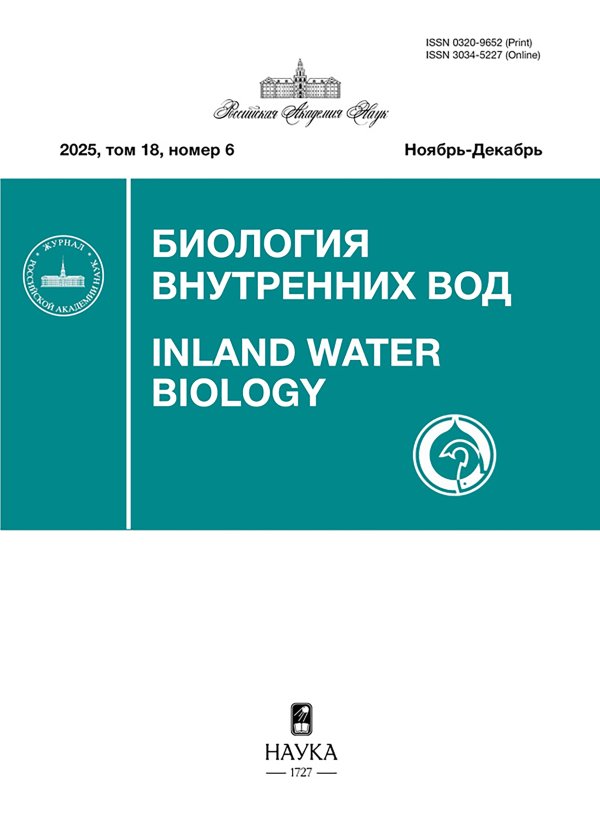Features of Plankton Metabolism: Results of Automated Measurements in the Mozhaisk Reservoir
- Authors: Goncharov A.V.1, Puklakov V.V.1, Grechushnikova M.G.1, Yumina N.M.1
-
Affiliations:
- Lomonosov Moscow State University
- Issue: No 1 (2023)
- Pages: 28-34
- Section: ФИТОПЛАНКТОН, ФИТОБЕНТОС, ФИТОПЕРИФИТОН
- URL: https://journals.rcsi.science/0320-9652/article/view/134881
- DOI: https://doi.org/10.31857/S0320965223010060
- EDN: https://elibrary.ru/KSGSFO
- ID: 134881
Cite item
Full Text
Abstract
Plankton metabolism determines fluctuations in the oxygen concentrations of a water body, its ecological condition, and exchange of СО2 with the atmosphere. We used an automated device that allowed us to make mass measurements of intraday values of the gross primary production (GPP) and respiration (R) of plankton. During our studies of the Mozhaisk reservoir (Russia) in the summer of 2017, we established an important fact: the maximum values of GPP are observed essentially earlier in the daytime than those of R. This is explained by the fact that GPP is related to solar radiation (the maximum values are observed at noon), whereas R is related to the temperature of water, which reaches its maximum several hours after in the afternoon. As a result, the maximum value of dissolved oxygen is observed in the second half of the day, when GPP and R become even. The device we have designed may be used for continuous monitoring of metabolism of plankton and of its responses to various hydrometeorological, hydrochemical and anthropogenic impacts.
About the authors
A. V. Goncharov
Lomonosov Moscow State University
Author for correspondence.
Email: mama15333@mail.ru
Russia, Moscow
V. V. Puklakov
Lomonosov Moscow State University
Email: mama15333@mail.ru
Russia, Moscow
M. G. Grechushnikova
Lomonosov Moscow State University
Email: mama15333@mail.ru
Russia, Moscow
N. M. Yumina
Lomonosov Moscow State University
Email: mama15333@mail.ru
Russia, Moscow
References
- Винберг Г.Г. 1960. Первичная продукция водоемов. Минск: Изд-во АН БССР.
- Девяткин В.Г., Метелева Н.Ю., Митропольская И.В. 2000. Гидрофизические факторы продуктивности литорального фитопланктона: корреляционные связи между гидрофизическими факторами и продуктивностью фито планктона // Биология внутр. вод. № 3. С. 42.
- Гончаров А.В., Гречушникова М.Г., Пуклаков В.В. 2018. Новые возможности классического метода: автоматизированное определение первичной продукции и деструкции органического вещества в водоеме // Биология внутр. вод. № 4. С. 107. https://doi.org/10.1134/S0320965218040083
- Девяткин В.Г., Метелева Н.Ю., Вайновский П.А. 2012. О роли фитопланктона в формировании кислородного режима водоема в связи с климатическими вариациями. Вода: Химия и экология. № 12. С. 68.
- Минеева Н.М. 2009. Первичная продукция планктона в водохранилищах Волги. Ярославль: Принтхаус.
- Минеева Н.М., Корнева Л.Г., Соловьева В.В. 2016. Фотосинтетическая активность фитопланктона водохранилищ р. Волги // Биология внутр. вод. № 2. С. 11. https://doi.org/10.7868/S0320965216020121
- Пуклаков В.В., Даценко Ю.С., Гончаров А.В. и др. 2015. Гидроэкологический режим водохранилищ Подмосковья (наблюдения, диагноз, прогноз). Москва: Изд-во “Перо”.
- Belova S.L., Kremenetskaya E.R. 2010. The effect of water level variations on production destruction processes in the Mozhaisk reservoir // Water Res. V. 34. № 1. P. 70. https://doi.org/10.1134/S0097807810060060
- Depew D., Smith R., Guildford S., 2006. Production and Respiration in Lake Erie Plankton Communities // J. Great Lakes Res. V. 32. Issue 4. P. 817.
- Goncharov A.V. 2007. Comparison of reservoirs in the Moskva-Vazuza water system in terms of phytoplankton abundance and eutrophication degree // Water Res. V. 34. № 1. P. 78. https://doi.org/10.1134/S0097807807010071
- Hanson P.C., Pollard D.L., Bade K. et al. 2004. A model of carbon evasion and sedimentation in temperate lakes // Global Change Biol. V. 10. P. 1285. https://doi.org/10.1111/J.1529-8817.2003.00805.X
- Hanson P.C., Carpenter S.R., Kimura N. et al. 2008. Evaluation of metabolism models for free-water dissolved oxygen methods in lakes // Limnol., Oceanogr. Methods 6: P. 454. https://doi.org/10.4319/lom.2008.6.454
- Hoellein T.J., Bruesewitz D.A., Richardson D.C. 2013. Revisiting Odum (1956): A synthesis of aquatic ecosystem metabolism // Limnol., Oceanogr. V. 58. № 6. P. 2089. https://doi.org/10.4319/lo.2013.58.6.2089
- LaBuhn S., Klump J.V. 2016. Estimating summertime epilimnetic primary production via in situ monitoring in a eutrophic freshwater embayment, Green Bay, Lake Michigan // Journal of Great Lakes Research. V. 42. Issue 5. P. 1026. https://doi.org/10.1016/J.JGLR.2016.07.028
- McNair J., Sesselmann M., Kendall S. et al. 2015. Alternative approaches for estimating components of lake metabolism using the free-water dissolved-oxygen (FWDO) method // Fundamental and Applied Limnology. V. 186 (1–2). P. 21. https://doi.org/10.1127/fal/2015/0626
- Odum E.P. 1983. Basic ecology. USA: Philadelphia Saunders College Publ.
- Staehr P.A., Sand-Jensen K. 2007. Temporal dynamics and regulation of lake metabolism // Limnol., Oceanogr. V. 52 (1). P. 108. https://doi.org/10.4319/lo.2007.52.1.0108
- Staehr P.A., Bade D., Van de Bogert M.C. et al. 2010. Lake metabolism and the diel oxygen technique: State of the science // Limnol., Oceanogr. Methods 8. P. 628. https://doi.org/10.4319/lom.2010.8.0628
- Staehr P.A., Testa J.M., Kemp W.M. et al. 2011. The metabolism of aquatic ecosystems: history, applications, and future challenges // Aquat. Sci. V. 74. P. 15. https://doi.org/10.1007/s00027-011-0199-2
- Vinçon-Leite B., Casenave C. 2019. Modelling eutrophication in lake ecosystems: A review // Science of The Total Environment. V. 651. Part 2. P. 2985. https://doi.org/10.1016/j.scitotenv.2018.09.320
- Wetzel R.G. 2001. Limnology. Lake and River Ecosystems. San Diego: Acad. Press.
- Wetzel R.G., Likens G.E. 2000. Limnological analyses. New York: Springer.
- Williams P., Jle B., Thomas D.N., Reynolds C.S. 2002. Phytoplankton Productivity. Carbon assimilation in marine and freshwater ecosystems. Oxford: Blackwell Science.
Supplementary files













